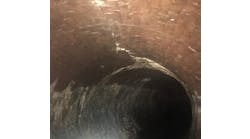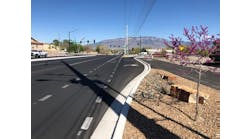Surface and subsurface infrastructures are the lifeblood of our modern society. Pipes, conduits, culverts and manholes all provide the essentials that make our day-to-day life easier. As with any materials exposed to the ravages of time and the natural environment, these facilities settle, crack, erode, corrode, offset, deteriorate, vibrate, become saturated, voided or collapse creating subsurface and surface repair work to be paid for by ever-stressed maintenance budgets. Each year, state governments, municipalities, cities, towns and counties are faced with the perplexing problem of how to address the issue of finding the resources and the effective means of solving these infrastructure problems that are so common today. Some of the more common problems include:
Water infiltration: If a precast manhole settles because of weak base soils, then there’s a real possibility that the pipe draining into or out of the manhole will crack or break (see Fig. 1). If the manhole is of the old brick and mortar variety, then wall cracks may develop where mortar lines have deteriorated. The result of such sewer manhole conditions is the possibility of additional storm water entering the system, yielding higher water treatment costs downstream. With time and erosion, roadway surfaces around manholes and catch basins can sink, creating opportunities for large amounts of soil and water to infiltrate.
Water exfiltration (leaching): When concrete, plastic, clay and even steel pipes that carry waste water and sewage crack, they can seep pollutants and harmful bacteria such as E. coli into surrounding ground soils. This situation can devastate the environment. Over time, these pollutants can penetrate underground aquifers and taint municipal drinking-water supplies. Areas of concern for these seepage problems include entry and exit piping for water-treatment plants, storm drains and sewer pipes. These infrastructures must be sealed against wastewater seepage as municipalities comply with strict rules imposed by the EPA concerning the disposal of waste products and storm water runoff.
Communication and data systems conduits: As communities transition their underground communication assets from standard wiring to fiber-optic cabling, the influence of water into the conduits that encase these assets can have damaging results. Many public and private agencies are taking steps to ensure that the conduits and vaults that protect these assets are sealed and protected from water infiltration. The same holds true for subway and underground rapid-transit tunnels and stations as well as underground pedestrian walkways and commercial areas.
Insulation from temperature and vibration: With particular infrastructures, such as oil pipelines, the rapid flow of large quantities of material can cause vibrations that transfer to support structures and concrete foundations. Such vibrations can destabilize these concrete bases as well as the underground soils that support them. In northern climates, changing temperatures and repetitive freeze-thaw cycles also can contribute to destabilization and disruption of the supporting ground soil.
Injecting medicine
Deep polymer injection is a new patented process for pavement lifting and soil stabilization that can save both time and money for states, counties, cities and municipalities with infrastructure maintenance and restoration projects. Polymer offers superior advantages over less-effective traditional methods and materials by filling, densifying and stabilizing low-density compressible soils to depths of 30 ft and beyond. It is ideal for sealing manholes, pipes, sewers and conduits, as well as box culverts and storm drains that have leakage problems. It also is fast-acting and hydro-insensitive, ensuring that it is unaffected by any water or wet soil that may exist around the immediate area.
The expansive properties inherent with polymer provides a non-disruptive, cost-effective and long-lasting solution for lifting sunken highways, roads and runways and misaligned bridge approaches or departure slabs. The equipment, labor and material costs involved with using polymer for infrastructure repair is significantly reduced because there is no need to take either the transportation or infrastructure elements out of service during peak-use periods. As a result, any significant traffic interruptions are minimized, leading to additional cost savings.
These unique attributes offer several important benefits that are useful for sealing, stabilizing and lifting a wide variety of public and private infrastructures.
Sealing
To seal infrastructure water leaks, the patented polymer material is strategically injected on either side of the offending area at depths up to 30 ft below the surface. Once the placement of the material is complete, it begins its expansion process. Since the polymer material can expand up to 20 times its original size, the material seeks out and fills any subsurface voids, fully enveloping and collaring the area, sealing the leak (see Fig. 2).
The expansion of the polymers and the hydro-insensitive nature of the material combine to compress the adjacent soil, push out any water in its expansion path and prevent any additional water from returning to that location. When the material fully cures, within mere minutes, it provides a strong, stable and long-lasting seal. For infrastructures such as conduits or vaults that encase cabling or wiring, the polymer material can be injected from either outside (the positive side of the leak) or inside of the enclosure (the negative side of the leak) to seal cracks and protect the assets from further water intrusion.
Stabilizing
Stabilizing involves reinforcing and adding support to the structural integrity of subsurface infrastructures by preventing displacement or incremental movement that can lead to cracks and leaks.
With brick manholes, hydrogen sulfide gas (H2S) over time can degrade the brick mortar causing cracks and shifting, finally exposing the bare dirt wall behind them. With the influence of water, this soil may seep into the manhole, clogging pipes and equipment located between the manhole and downstream water-processing plants.
To solve these stabilization problems, the polymer material can be injected from the surface, the floor or through the manhole wall itself to fill the voids and spaces wherever cracks may exist. The injections can continue all the way around the manhole structure as necessary, creating a unified and solid mass of polymer material retarding the penetration of both water and base soils. Since the weight of the material is a fraction of the comparable weight of cementitious grouts, it does not add any overburden to the wall or the surrounding soils that could contribute to further structural movement.
Lifting
Deep polymer injection also is effective in repairing transportation assets more effectively and at lower cost. Changing temperatures between summer and winter months combined with the ongoing punishment by heavy traffic results in the underlying base spewing out dirt and water at the slab joints, creating a situation where one concrete slab may be higher or lower than another section. This in turn creates that familiar “washboard” effect, presenting disturbing and potentially dangerous road conditions.
Even though work crews could seal the cracks, fill the dips and lay down new asphalt, it would only mask the underlying problem, requiring subsurface maintenance on the same patch of highway to be re-addressed again at a future date.


